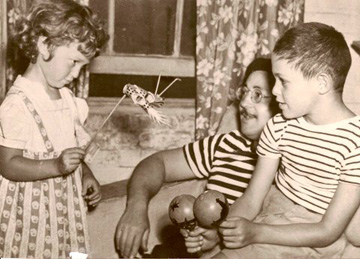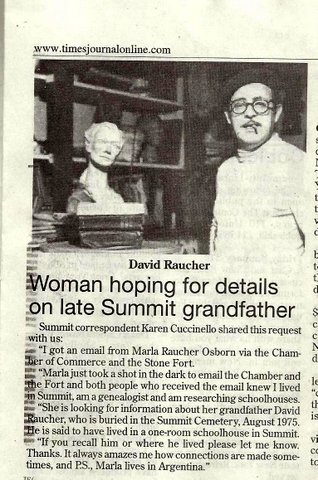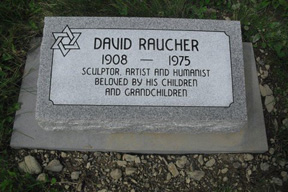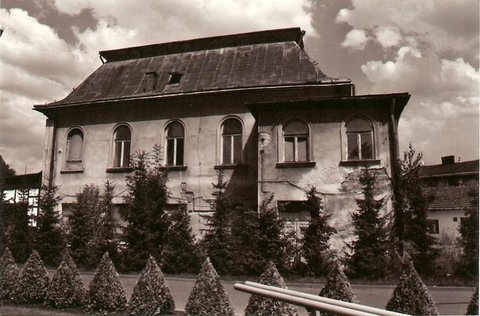
Finding My Grandfather David Raucher
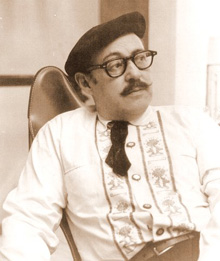
Greenwich Village, New York
A year ago I knew nothing about him or his parents or his grandparents. A week ago I was standing in the overgrown ruins of a Jewish cemetery in Przemysl, Poland (Galicia). I admit. I exaggerate a little—but only a little. Around 1974, at the age of 14, I had had enough and wanted to know. My grandfather David Raucher had never been in my life. I had never met him. I did not even know if he was still alive. My dad and his sister had been whisked away from New York City to Los Angeles, California, by their mother as part of a contentious divorce that had ripped father from children. My dad was age 7 when he last saw his father. His younger sister was age 4. The year was 1942. Over 30 years had passed without any contact between David and his children.
As a child, knowing all three of my other grandparents, I remember being disturbed that this grandparent was "missing". And worse, was that no one seemed to know where he might be or if he was still living. "Why hadn't David ever tried to find us?" I asked myself. Did he know he was a grandfather? Did he care? Despite the passing of these 30 years, my grandmother (David's ex-wife) still refused to talk about him. Her anger and hurt following the divorce had apparently been so intense that she had snipped David out of the few family photos that existed. I didn't even knew what David looked like. Of course, while growing up I had heard a few details about him. David had been a sculptor in New York. David had had a cafe in Greenwich Village named Jabberwocky where poets and artists would hang out. He was a libertine according to my great aunt, the younger sister of my grandmother, and he was constantly unemployed and financially irresponsible. I needed to know what became of David. I needed to find him. So, in stubborn, precocious, resolute fashion (typical of me then and now), I managed to get my pre-teen hands on a New York City phone book (or maybe several, I no longer recall). I did not tell my dad or my grandmother. Nor did I tell anyone when I wrote letters to all the "David Rauchers" that appeared in the phonebook. I waited. After a few weeks, a strange letter arrived addressed to me. I say "strange" because it was written on aluminum foil—both envelope and letter! But I could read it! And it was from David! I thought: "still the artist, the black sheep, the eccentric!" I already loved that about him. To a 14-year old girl from a relatively conventional middle class Los Angeles family, this was just fantastic! David was coming out to California—and as soon as possible I broke the news to my dad. We never told my grandmother. David arrived in a psychedelic-painted, old school bus. He was re-married to a woman 30 years his junior. He had his wife and three small children with him, only one of which was his biologically. The children ranged in age from 5 to about 11. I remember being both confused and amused that my father now had a half-brother and two half-sisters almost 30 years his junior, and I had an uncle and two aunts considerably younger than me! Things couldn't have been more interesting as far as I was concerned. David arranged to rent a house near us for an extended visit. I remember going over there several times in the next few months to visit. It was all very emotional for my dad and his sister. David said he had tried many times to get in contact with his children after the divorce, but had been prevented from seeing them. He said he had also traveled to California several times and written letters, all of which went unanswered. He did not know what to think. Until now. There were a lot of tears during those visits with David, and sometimes a lot of shouting between David, my dad, and my dad's sister. I didn't like that part, but somehow I understood that this was necessary for the three of them to bridge the years and correct the misconceptions. David brought with him photos none of us had ever seen—photos of David working in his studio in the Village; photos of David with his children—my dad and his sister—at his side; photos of them all laughing. David also brought a bust that he had sculpted of my dad as a child, before the family had disintegrated. He gifted this (and other pieces) to my dad. To my dad's sister, David presented a foot-high sculpture he had made of my dad and his sister as young children, walking hand in hand. After all these years, and despite no word from his son and daughter, David had still treasured these pieces; pieces that he had fashioned by his own hands, from memories when they had been a family. After several months, David and his family returned to New York in their school bus. Their "real" home was an old historic schoolhouse somewhere in upstate New York. They planned to do some travels between California and New York before returning. I recall it was around the end of summer when they left. Their children needed to get back to their schooling (even though they were home-schooled and even though I didn't quite understand what this even meant). Less than a year later, we got a phone call from David's wife. David had passed away peacefully in his sleep of a heart attack. David had been 67. I was sad but somehow content that we had met, even if it had been too brief. It had certainly been memorable. So, now we jump back to the present. Over the intervening years, I grew, schooled, married, moved to the San Francisco Bay Area, divorced, re-married, worked a career in law. Throughout, but at varying degrees, I continued to feed my lust for family history and tales, mining elderly family members, grandparents, and forgotten photo albums. Most of my efforts, I admit, concentrated on the other sides of my family (Rohatyn in Galicia, Mogilev-Podolsky in today's Ukraine, and Soroka in Bessarbia). I made tremendous and exciting progress with several of these families, particularly in the last two years as more and more records went online, many from countries like Poland and Ukraine, and I got involved with groups like JewishGen and Gesher Galicia. But, I still knew virtually nothing about the Raucher side and could not seem to move forward. Sadly, but not unexpectedly, I had never thought to ask David about his parents and grandparents when he had been alive. Fortunately, I had somewhat obliquely questioned my grandmother (David's ex) before her death in 2004, as well as her younger sister who had known David because she had lived with the Raucher family in the Village before the 1942 divorce. I still had their letters and notes. I hit the online records for New York City, Ellis Island, Jewish Records Indexing-Poland, and other sites on the internet. I obtained passenger lists, ordered records from AGAD (Archiwum Glowne Akt Dawnych—the Central Archives of Historical Records in Warsaw), and obtained New York birth and marriage records. At last "Przemysl" in Galicia, appeared as the "home" in the Old World from whence came my Raucher (now, also Rauscher) family!
From these records, I learned the reason why David's oldest son by his second, younger wife (my dad's half-brother) was named Marcus: because David's father's name had been "Marcus Osias" (Mordechai Ishaya, in some AGAD records). Marcus Osias had died at age 28 in NYC in 1911, leaving behind a young widow, David's mother Tillie, as well as David (then, age 3), and David's older sister Agnes (then, age 4). I learned that Marcus Osias is today buried near his father, Selig Rauscher, who died in 1912, at Mt. Zion, in Queens, New York. I also realized from reviewing various records that my father's name, Tobin, came from Tillie. Tillie had been the wife of Marcus Osias, thus my great-grandmother. My grandmother had told me that she had liked Tillie very much, and that Tillie had passed a few years before my father had been born, dying a slow, painful death from stomach cancer, bedridden and in pain, living with David and my grandmother. The year was 1930. At last armed with some concrete dates, names, and places, I made some online inquiries and joined an informal, newly-formed Przemysl research group. I spoke with others with Przemysl connections. I was contacted through JewishGen's Family Finder by someone also researching the Raucher family: we learned that his family came off a sibling line to Marcus Osias. I shared information on Facebook with others seeking Przemysl family. I knew someday I would visit this place, today at the Poland-Ukraine border. After all, my husband and I travel extensively and have been living abroad most of the last decade. Przemysl was relatively close to most of our travels and thus added to the "must-do" list. At the beginning of 2011, I decided to focus on David's last years in the upstate New York old red schoolhouse. Where to start? The family had not spoken to David's widow for years and had lost touch with David's three children. The big break came when I found information for David in the Social Security Death Index and I was then able to lay my hands on his death certificate: Summit, New York. This had been his last known address. I searched online and found the Summit Historical Society and emailed them. Almost immediately I was contacted by a woman named Karen Cuccinello, a local resident and advocate of "all things Summit". She knew of an old red schoolhouse that had been torn down a few years prior and the land now belonged to the Summit Fire Department. She went to the local records. She found deeds. She found David's probate file and Will. I learned that the schoolhouse had been foreclosed upon for back taxes after David's death. I learned that David had been buried in 1975 in a tiny little cemetery not far from the schoolhouse. Karen went to the cemetery to shoot some photos for me; there was no headstone at his grave. A sad ending, I thought. I cried. My dad cried.
Fortunately for me, Karen is as resourceful as I am tenacious. She suggested I write an article about David for the local Summit newspaper, which I did. I enclosed the old photo David had given all of us in 1974 of him working in his studio and wearing his trademark black French beret. The article ran and produced many, many emails from people who remembered David. One such reply amusingly recalled how David had "modified" the interior of the old schoolhouse by building a swing for his children in the main room, hanging from the rafters! (This little anecdote prompted me to remember that David had constructed a similar indoor swing apparatus in the house he and the family had rented in 1974!) Several people who replied remembered the rare Bugati automobiles that David had collected and restored on the schoolhouse property. A few people sent me photos. Karen found an old photo of the schoolhouse before its destruction. From sadness came contentment. After six months of planning and waiting for the snow to melt and the ground to thaw, a headstone was finally erected at David's gravesite at the Summit cemetery. A few days later, I gingerly stepped among the ivy vines and lush wet grass licking the old broken and forgotten Jewish headstones of the Przemysl "new" Jewish cemetery. I have yet to find a headstone there that says Raucher or Rauscher, but I know they are there. Afterword Through my research using the databases and websites of Jewish Records Indexing-Poland and Gesher Galicia, plus numerous letters and emails to archives in Krakow, Warsaw, and Przemysl, I have obtained copies of some records for David's father and grandfather from Przemysl and their siblings. These historic vital records include an 1883 Przemysl birth record for Marcus Osias Raucher, David's father, as well as Marcus' 1897 passenger ship manifest from Przemysl to New York. Through the Ellis Island Database I also now have the 1891 passenger manifest for Selig Rauscher, Marcus' father and David's grandfather, who also traveled from Przemysl to New York. These sources confirm that the family was in the jewelry business back in Przemysl, a profession that David himself carried on as a young man before devoting himself full-time to sculpting in Greenwich Village.
Both Marcus and Selig—David's father and grandfather—died in New York (1911 and 1912, respectively). Both are buried at Mt. Zion cemetery in Queens, New York. Sadly, Marcus died of tuberculosis at age 28, leaving behind Tillie (David's mother), now a young widow caring for two infant children—David (age 3) and his older sister Agnes (age 4). Tillie would re-marry in later years, but would herself die prematurely at age 43 of ovarian cancer, living at the time with David and his new young bride Annie Horn, originally from Rohatyn, a town also located in Galicia like Przemysl. Tillie's memory would carry on through the naming of David and Annie's first born child, Tobin, my father. The history of Galicia—where Przemysl is located—and its importance in the Austro-Hungary Empire is a topic beyond the scope of this brief, personal article; however, its uniqueness in the Empire and in Europe as an academic center of learning, cannot be overstated. Women in Galicia in the late 19th and early 20th centuries, including Jewish women, not only had equal access to education in the most prestigious institutions of higher learning in cities like Vienna, Budapest, Krakow, and Lwow, but they also came to dominate several coveted professions such as medicine in, for example, pre-War Krakow.
It wasn't until 1933 and Hitler's rise to power that quotas legally restricting the number of Jewish students in these Universities ended this regional Galician phenomenon. Unlike family I have researched through David's wife's line—specifically those from Rohatyn—the Rauchers appear to have left their Galician home of Przemysl because they perceived greater economic opportunities in the New World. They did not leave because War was about to break out or because anti-Jewish laws were strangling their lives and livelihood (like my Rohatyn family). More research into the broader historic events taking place at emigration (1891 and 1897) would be required for me to discuss this more definitively and academically. I have been fortunate to have met, through my research and the internet, other individuals researching their Jewish pre-War families from Przemysl, several of whom were early members, like myself, of a Przemysl online research group. This is a large group, and provides a lively and convenient forum for members to discuss family stories, town history, and share photos, maps, and records. I am grateful to many active members who provided me with useful information to make my September 2011 trip to Przemysl productive as well as interesting. Przemysl Town Center Finally, I would like to mention the lovely and well-preserved historic town center of Przemysl. Despite the devastation the town experienced in both World Wars (it repeatedly volleyed between German and Russian occupation), having now seen its bucolic setting on the San River and its steep rise to the historic restored castle on the hill, it is not hard to understand its coveted wartime capture and its recent restoration efforts. The former Jewish sites of Przemysl include several synagogues (one, an empty ruin; the other a functioning and restored public library), a Jewish hospital, and an extensive but very overgrown Jewish cemetery containing hundreds if not thousands of headstones dating back to prior centuries, mostly all unreadable today. The cemetery is otherwise well-maintained, locked, and fenced thanks to funds raised by a few individuals and groups, including the founders of the Przemysl online research group. During the War, the City had a vast Jewish ghetto, the history of which is well documented and too broad to discuss here. Suffice it to say that there are historic maps, Yizkor Book stories, and old photos, all of which are available in bookstores and the museum in town and on the internet through sites such as JewishGen. Several buildings of Jewish significance have markers and plaques designating them as such, and there is a worthwhile walk that can easily be made re-tracing the boundaries of the Jewish ghetto and sites of martyrdom under the Nazi occupation. Photos from our September 2011 visit to Przemysl can be seen here: Przemysl Photos January 2013
|
||||||||||||||||||||||||||||||||||||
